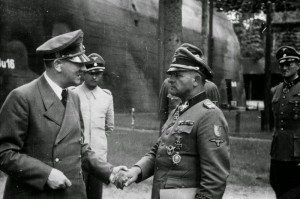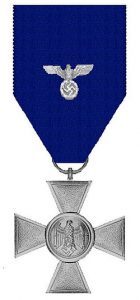Karck, Georg „Oschi“ Heinrich Karl, born 11-06-1911, in Segeberg, Holstein,  joined the NSDAP from 01-10-1931, Nr 756.882 and he as “SS-Obersturmführer has been a member of the LSSAH since 10-06-1933, SS Nr..17.690, the 1. SS-Panzer-Division „Leibstandarte-SS Adolf Hitler“
joined the NSDAP from 01-10-1931, Nr 756.882 and he as “SS-Obersturmführer has been a member of the LSSAH since 10-06-1933, SS Nr..17.690, the 1. SS-Panzer-Division „Leibstandarte-SS Adolf Hitler“ 
 under command of SS-Obergruppenführer Josef “Sepp” Dietrich
under command of SS-Obergruppenführer Josef “Sepp” Dietrich

 He participated in the Russian campaign during 1941/42 as a Zugführer, and was awarded the Iron Cross Second Class.
He participated in the Russian campaign during 1941/42 as a Zugführer, and was awarded the Iron Cross Second Class. As a Kompanie commander he and his Machine Gun-Kompanie consistently fought at the hotspots of combat during the Regiment’s difficult defensive battles in the winter of 1943, and was awarded the Iron Cross First Class in March 1943.SS-Obersturmführer Karck
As a Kompanie commander he and his Machine Gun-Kompanie consistently fought at the hotspots of combat during the Regiment’s difficult defensive battles in the winter of 1943, and was awarded the Iron Cross First Class in March 1943.SS-Obersturmführer Karck ![]() made a major contribution to the success of the Regiment during the hard breakthrough battles west of Belgorod. On the 04-07-1943 the Regiment had the task of sending a Bataillon into battle in order to seize the enemy outposts on Hill 228.6 (northwest of Jachontoff) in a surprise attack. This would secure the jump-off position for the attack set for the 05-07-1943 that would initiate the assault against the 15-20 km deep enemy field positions on a broad front. On the night of the 04-05 July 1943 SS-Obersturmführer Karck stormed Hill 228.6 at the head of his men, wresting control of the enemy bunker and trench system (which was fully protected by mines and barbed wire) on the hill from the bitterly defending foe. Undeterred by the determined defense and his own losses, he inspired his men forward with his personal example and threw the enemy off the hill meter by meter. Personally fighting at the front of the Kompanie, he cleared 3 enemy bunkers with hand grenades. The entire enemy garrison of the bunker/trench system atop of Hill 228.6, in the strength of a reinforced company, was either killed or captured. An immediate Russian counterthrust was smashed in a man to man fight, an achievement made possible by the swift recognition of the critical situation. Only the personal initiative, outstanding boldness and determined obstinacy of SS-Obersturmführer Karck is to be credited for the fact that the Hill 228.6 remained in our hands after a two and a half hour bloody engagement. With this the precondition for the Regiment’s assault was achieved. During this fight SS-Obersturmführer Karck was wounded in the head,
made a major contribution to the success of the Regiment during the hard breakthrough battles west of Belgorod. On the 04-07-1943 the Regiment had the task of sending a Bataillon into battle in order to seize the enemy outposts on Hill 228.6 (northwest of Jachontoff) in a surprise attack. This would secure the jump-off position for the attack set for the 05-07-1943 that would initiate the assault against the 15-20 km deep enemy field positions on a broad front. On the night of the 04-05 July 1943 SS-Obersturmführer Karck stormed Hill 228.6 at the head of his men, wresting control of the enemy bunker and trench system (which was fully protected by mines and barbed wire) on the hill from the bitterly defending foe. Undeterred by the determined defense and his own losses, he inspired his men forward with his personal example and threw the enemy off the hill meter by meter. Personally fighting at the front of the Kompanie, he cleared 3 enemy bunkers with hand grenades. The entire enemy garrison of the bunker/trench system atop of Hill 228.6, in the strength of a reinforced company, was either killed or captured. An immediate Russian counterthrust was smashed in a man to man fight, an achievement made possible by the swift recognition of the critical situation. Only the personal initiative, outstanding boldness and determined obstinacy of SS-Obersturmführer Karck is to be credited for the fact that the Hill 228.6 remained in our hands after a two and a half hour bloody engagement. With this the precondition for the Regiment’s assault was achieved. During this fight SS-Obersturmführer Karck was wounded in the head,  but remained with his Kompanie.On the 05-07-1943 the Regiment began its assault on a broad front towards Bykowka in the face of a deep enemy field position heavily protected by mines, barbed wire and anti-tank ditches. Here SS-Obersturmführer Karck and his Kompanie once again formed the spearhead of the Regiment. He was the first to reach the anti-tank ditch south of Hill 220.5 with a small assault party. He cleared a lane through a minefield for the following Sturmgeschütze and Panzers, and then clawed his way forward with his men to the foot of Hill 220.5. From here he broke into the enemy positions on the hill with almost superhuman strength. A shining example, a leader in a decisive moment, a goal-oriented lone fighter, SS-Obersturmführer Karck took on all of these mantles as he wrested a portion of the enemy’s trench/bunker system from their possession. Along with Pak and MG positions, he cleared out the enemy defenses and in doing so completed the breach necessary for the further breakthrough of our forces towards Bykowka.
but remained with his Kompanie.On the 05-07-1943 the Regiment began its assault on a broad front towards Bykowka in the face of a deep enemy field position heavily protected by mines, barbed wire and anti-tank ditches. Here SS-Obersturmführer Karck and his Kompanie once again formed the spearhead of the Regiment. He was the first to reach the anti-tank ditch south of Hill 220.5 with a small assault party. He cleared a lane through a minefield for the following Sturmgeschütze and Panzers, and then clawed his way forward with his men to the foot of Hill 220.5. From here he broke into the enemy positions on the hill with almost superhuman strength. A shining example, a leader in a decisive moment, a goal-oriented lone fighter, SS-Obersturmführer Karck took on all of these mantles as he wrested a portion of the enemy’s trench/bunker system from their possession. Along with Pak and MG positions, he cleared out the enemy defenses and in doing so completed the breach necessary for the further breakthrough of our forces towards Bykowka.
Fully exploiting the situation, he pursued the fleeing enemy, stirring up the final ounces of strength from his exhausted troops with his inspiring example. In this continued advance he prevented the enemy from regrouping in Bykowka, bypassed their defenses there and stormed Hill 243.8 (located north of Bykowka, and the Regiment’s objective for the day). Through ruthlessly pushing ahead, while sparing himself nothing, he was a model of courage and bravery for his men. By these actions SS-Obersturmführer Karck had a significant share in ensuring his Regiment reached its objectives for the day. Outstanding bravery and courage, dogged determination, as well as calm and highly effective leadership are the skills of SS-Obersturmführer Karck. For his outstanding courage I ask that he be awarded the Knight’s Cross to the Iron Cross.” ![]() .
.
Death and burial ground of Karck, Georg „Oschi“ Heinrich Karl..



Georg Karck was killed in his accident-damaged vehicle on the road between L’Aigle and Rugles (Normandy) in July 1944, a few weeks after D-Day  , southeast of Caen, where the battle was just raging. Shortly before, he had been appointed leader of the 2nd Battalion of the 2nd SS Panzer Grenadier Regiment
, southeast of Caen, where the battle was just raging. Shortly before, he had been appointed leader of the 2nd Battalion of the 2nd SS Panzer Grenadier Regiment
Occasionally, enemy low-flying aircraft, partisans or infantry action are reported. However, his son reported in 1996 that his father had had a fatal accident in his car without enemy influence when he was hit by an ammunition truck (at night and when blackout was ordered). However, since this happened not far from a war front, the fallen status according to the prevailing martial law remains upright, similar to a pilot who crashes during an enemy flight after an engine failure.
SS Sturmbannführer Karck, Georg „Oschi“ Heinrich Karl .was on 03-07-1944, age 33, killed in battle, southeast of Caen. He is buried at the Cemetery of Champigny-St.André; Final grave site: Block 9, Row 27, Grave 1876. The cemetery is located 5 kilometers South of the village of Saint-André-de-l’Eure, about 25 km (16 mi) south east of Évreux. The burials come from the summer of 1944, as the Allies pushed out of Normandy towards Paris. It is the second largest of the six German war cemeteries in Normandy with a nearly 20,000 burials.






























Leave a Reply